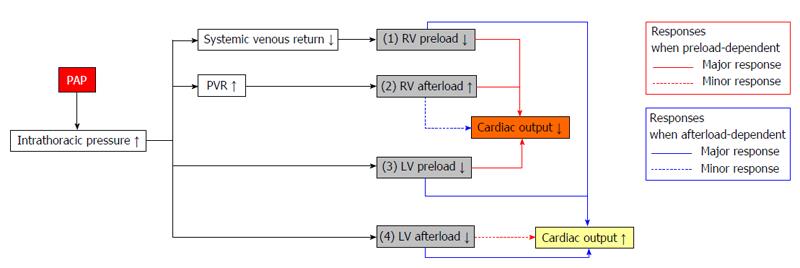Copyright
©2014 Baishideng Publishing Group Inc.
World J Cardiol. Nov 26, 2014; 6(11): 1175-1191
Published online Nov 26, 2014. doi: 10.4330/wjc.v6.i11.1175
Published online Nov 26, 2014. doi: 10.4330/wjc.v6.i11.1175
Figure 1 Effects of positive airway pressure on hemodynamics.
First, PAP decreases systemic venous return and RV preload by increasing intrathoracic pressure; Second, PAP increases PVR by increasing lung volume. Thus, it is possible that RV afterload can be increased by PAP; Third, a decrease in RV preload and an increase in RV afterload lead to reductions in pulmonary venous return and limitations of LV inflow, filling and preload; Fourth, increased intrathoracic pressure relative to atmospheric pressure causes a pressure difference between the intrathoracic and extrathoracic cavities. Therefore, PAP may decrease LV afterload. In subjects without HF who are generally preload-dependent or in HF patients who manifest preload-dependent reduction, decreased RV and LV preload in addition to the increase in RV afterload may cause a net decrease in cardiac output, whereas a decrease in LV afterload may cause a minor response toward increasing cardiac output. Conversely, patients with HF are more sensitive to decreased afterload and are thus predominantly afterload-dependent. PAP therapy causes a net increase in cardiac output through decreases in RV preload, LV preload and afterload, whereas an increase in RV afterload may cause a minor response toward decreasing cardiac output. LV: Left ventricular; PAP: Positive airway pressure; PVR: Pulmonary vascular resistance; RV: Right ventricular; HF: Heart failure.
- Citation: Kato T, Suda S, Kasai T. Positive airway pressure therapy for heart failure. World J Cardiol 2014; 6(11): 1175-1191
- URL: https://www.wjgnet.com/1949-8462/full/v6/i11/1175.htm
- DOI: https://dx.doi.org/10.4330/wjc.v6.i11.1175









